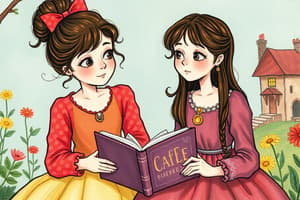Podcast
Questions and Answers
What are literary devices?
What are literary devices?
- Techniques used in writing to produce a specific effect on the reader (correct)
- Narrative techniques used to introduce events in a non-linear way
- Devices used to distract the reader's attention
- Characters introduced by the author to advance the plot
What is a deathtrap?
What is a deathtrap?
- A literary device that allows characters to share past or future events with the reader
- A narrative technique used to introduce events in a non-linear way
- A plot device used by villains to try to kill the protagonist (correct)
- A vision device used to foreshadow events
What is deus ex machina?
What is deus ex machina?
- A plot device where an impossible problem is solved by an unrelated element introduced by the author (correct)
- A vision device used to foreshadow events
- A literary device that allows characters to share past or future events with the reader
- A narrative technique used to introduce events in a non-linear way
What is the difference between flashing arrow and red herring?
What is the difference between flashing arrow and red herring?
What is a twist ending?
What is a twist ending?
Flashcards are hidden until you start studying
Study Notes
- Literary devices are techniques used in writing to produce a specific effect on the reader.
- Plot devices are objects, characters, or concepts introduced by the author to advance the plot.
- Flashing arrow and red herring are plot devices used to focus or distract the reader's attention.
- Deathtrap is a plot device used by villains to try to kill the protagonist.
- Reverse chronology and 'in medias res' are narrative techniques used to introduce events in a non-linear way.
- Vision is a literary device that allows characters to share past or future events with the reader.
- Dream sequence, flashback, flash-forward, prophecy, and foreshadowing are vision devices.
- Ending devices include cliff-hangers, twist endings, happy endings, and deus ex machina.
- Deus ex machina is a plot device where an impossible problem is solved by an unrelated element introduced by the author.
- The Fairy Godmother in Cinderella is a perfect example of deus ex machina.
Studying That Suits You
Use AI to generate personalized quizzes and flashcards to suit your learning preferences.




